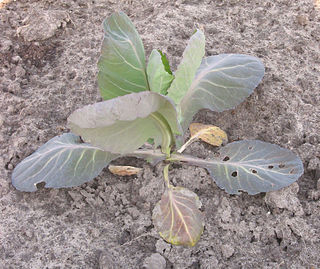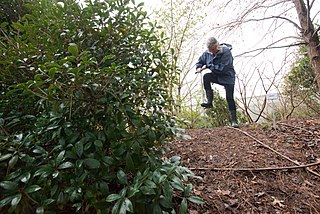
Crop rotation is the practice of growing a series of different types of crops in the same area across a sequence of growing seasons. This practice reduces the reliance of crops on one set of nutrients, pest and weed pressure, along with the probability of developing resistant pests and weeds.

Precision agriculture (PA) is a farming management strategy based on observing, measuring and responding to temporal and spatial variability to improve agricultural production sustainability. It is used in both crop and livestock production. Precision agriculture often employs technologies to automate agricultural operations, improving their diagnosis, decision-making or performing. First conceptual work on PA and practical applications go back in the late 1980s. The goal of precision agriculture research is to define a decision support system (DSS) for whole farm management with the goal of optimizing returns on inputs while preserving resources.

Nitrogen deficiency is a deficiency of nitrogen in plants. This can occur when organic matter with high carbon content, such as sawdust, is added to soil. Soil organisms use any nitrogen available to break down carbon sources, making nitrogen unavailable to plants. This is known as "robbing" the soil of nitrogen. All vegetables apart from nitrogen fixing legumes are prone to this disorder.

Sustainable agriculture is farming in sustainable ways meeting society's present food and textile needs, without compromising the ability for current or future generations to meet their needs. It can be based on an understanding of ecosystem services. There are many methods to increase the sustainability of agriculture. When developing agriculture within sustainable food systems, it is important to develop flexible business process and farming practices. Agriculture has an enormous environmental footprint, playing a significant role in causing climate change, water scarcity, water pollution, land degradation, deforestation and other processes; it is simultaneously causing environmental changes and being impacted by these changes. Sustainable agriculture consists of environment friendly methods of farming that allow the production of crops or livestock without damage to human or natural systems. It involves preventing adverse effects to soil, water, biodiversity, surrounding or downstream resources—as well as to those working or living on the farm or in neighboring areas. Elements of sustainable agriculture can include permaculture, agroforestry, mixed farming, multiple cropping, and crop rotation.

Soil test may refer to one or more of a wide variety of soil analysis conducted for one of several possible reasons. Possibly the most widely conducted soil tests are those done to estimate the plant-available concentrations of plant nutrients, in order to determine fertilizer recommendations in agriculture. Other soil tests may be done for engineering (geotechnical), geochemical or ecological investigations.

Nutrient management is the science and practice directed to link soil, crop, weather, and hydrologic factors with cultural, irrigation, and soil and water conservation practices to achieve optimal nutrient use efficiency, crop yields, crop quality, and economic returns, while reducing off-site transport of nutrients (fertilizer) that may impact the environment. It involves matching a specific field soil, climate, and crop management conditions to rate, source, timing, and place of nutrient application.
Harold F. Reetz Jr. was an American agronomist.

Netafim is an Israeli manufacturer of irrigation equipment. The company produces drippers, dripperlines, sprinklers and micro-emitters. Netafim also manufactures and distributes crop management technologies, including monitoring and control systems, dosing systems, and crop management software, as well as a variety of services, including managed irrigation, agronomical advisory and operation and maintenance. As of 2012, Netafim was the global leader on the fast expanding market of drip- and micro-irrigation. In it was the overall largest provider of drip irrigation systems, with a global market share of 30%.
Soil health is a state of a soil meeting its range of ecosystem functions as appropriate to its environment. In more colloquial terms, the health of soil arises from favorable interactions of all soil components that belong together, as in microbiota, plants and animals. It is possible that a soil can be healthy in terms of eco-system functioning but not necessarily serve crop production or human nutrition directly, hence the scientific debate on terms and measurements.
Upland rice is a type of rice grown on dry soil rather than flooded rice paddies. It is sometimes also called dry rice.

Agricultural machinery relates to the mechanical structures and devices used in farming or other agriculture. There are many types of such equipment, from hand tools and power tools to tractors and the countless kinds of farm implements that they tow or operate. Diverse arrays of equipment are used in both organic and nonorganic farming. Especially since the advent of mechanised agriculture, agricultural machinery is an indispensable part of how the world is fed. Agricultural machinery can be regarded as part of wider agricultural automation technologies, which includes the more advanced digital equipment and robotics. While agricultural robots have the potential to automate the three key steps involved in any agricultural operation, conventional motorized machinery is used principally to automate only the performing step where diagnosis and decision-making are conducted by humans based on observations and experience.

Manure is organic matter that is used as organic fertilizer in agriculture. Most manure consists of animal feces; other sources include compost and green manure. Manures contribute to the fertility of soil by adding organic matter and nutrients, such as nitrogen, that are utilised by bacteria, fungi and other organisms in the soil. Higher organisms then feed on the fungi and bacteria in a chain of life that comprises the soil food web.

The Climate Corporation is a digital agriculture company that examines weather, soil and field data to help farmers determine potential yield-limiting factors in their fields.
The International Fertilizer Development Center is a science-based public international organization working to alleviate global hunger by introducing improved agricultural practices and fertilizer technologies to farmers and by linking farmers to markets. Headquartered in Muscle Shoals, Alabama, USA, the organization has projects in over 25 countries.

Soil compaction, also known as soil structure degradation, is the increase of bulk density or decrease in porosity of soil due to externally or internally applied loads. Compaction can adversely affect nearly all physical, chemical and biological properties and functions of soil. Together with soil erosion, it is regarded as the "costliest and most serious environmental problem caused by conventional agriculture."

Indigo Agriculture is a Boston, Massachusetts-based agricultural technology company that works with plant microbes, aiming to improve yields of cotton, wheat, corn, soybeans, and rice. The company also offers crop storage and other logistics programs for farmers.

Granular Inc. is a San Francisco-based agricultural software development company focused on helping farmers be more profitable and efficient. The company's software products provide farmers tools to manage their financial performance and manage agronomic inputs for maximum performance and return. In addition to digital tools for farmers, Granular also owns AgStudio, a precision ag software company used primarily by ag retailers and professional agronomists, as well as AcreValue, a website that uses proprietary algorithms to provide estimated land values.
Digital agriculture, sometimes known as smart farming or e-agriculture, is tools that digitally collect, store, analyze, and share electronic data and/or information in agriculture. The Food and Agriculture Organization of the United Nations has described the digitalization process of agriculture as the digital agricultural revolution. Other definitions, such as those from the United Nations Project Breakthrough, Cornell University, and Purdue University, also emphasize the role of digital technology in the optimization of food systems.
Climate-smart agriculture (CSA) is an integrated approach to managing landscapes to help adapt agricultural methods, livestock and crops to the effects of climate change and, where possible, counteract it by reducing greenhouse gas emissions from agriculture, at the same time taking into account the growing world population to ensure food security. Thus, the emphasis is not simply on carbon farming or sustainable agriculture, but also on increasing agricultural productivity. "CSA ... is in line with FAO’s vision for Sustainable Food and Agriculture and supports FAO’s goal to make agriculture, forestry and fisheries more productive and more sustainable".
Guy Lafond was a research scientist for over 30 years with Agriculture and Agri-Food Canada at the Indian Head Research Farm in Saskatchewan. He was instrumental in establishing the Indian Head Agricultural Research Foundation (IHARF) in the early 1990s and had a major impact on cropping practices and soil conservation.












